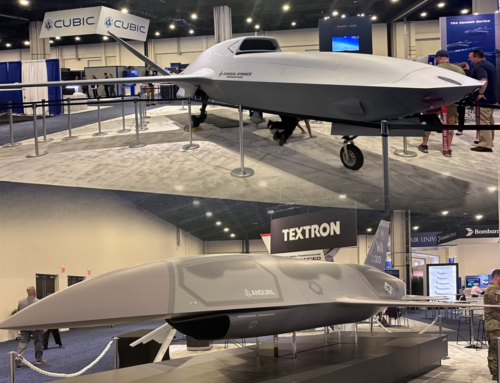RCO Director Kelly Hammett speaks on a panel at AFA 2024 on Sept. 20, 2024. (Air & Space Forces Association photo)
WASHINGTON — The Space Rapid Capabilities Office (Space RCO) has announced the first $12 million in delivery orders to 20 small businesses for its Rapid Resilient Command and Control (R2C2) program, designed to develop software that will allow Space Force operators to manage hundreds of highly mobile satellites and spacecraft being envisioned for future dynamic space operations.
“R2C2, a combined program with Space Systems Command, is developing a cloud-based satellite operations infrastructure that gives military operators more flexibility to command and reposition satellites in response to threats,” the Space RCO press release explained on Wednesday.
“The program will deliver critical, tactical ground segment software to operate dynamic USSF satellites with protect-and-defend missions and to provide many tactical SatOps functions such as Rendezvous and Proximity Operations (RPO) planning, antenna brokering and telemetry, and tracking and command,” it added.
Space RCO, headquartered at Kirtland AFB in New Mexico, is a semi-independent acquisition organization created by Congress in 2018 to take requirements directly from operators at US Space Command and find ways to quickly get capabilities, including cutting-edge commercial tech, into the field. Space Systems Command, headquartered in Los Angeles, is the Space Force’s major acquisition command.
Space Force Rapid Capabilities Office emblem. (RCO image, launch image via DVIDS)
Space RCO Director Kelley Hammett told Breaking Defense in a Sept. 17 interview that the office revamped its contracting approach this summer, deciding to award Indefinite Delivery/Indefinite Quantity contracts worth up to $1 billion total over five- to seven years to 20 small businesses.
“The approach was target people who actually know how to do software, versus large defense primes who say they can do software — but then you have OCX, you have ATLAS, you have all these examples of [Air Force space acquisition czar Frank] Calvelli’s bottom [performing] programs that have not delivered,” he said. “And so it’s a little bit of an experiment, but I think it’s a calculated experiment.”
OCX, for Next Generation Operational Control System, is being developed by RTX and is designed to provide C2 for the latest model GPS satellites, as well as allow operators “full control” of the jam-resistant, military-only GPS signal. It was originally planned to begin operations more than a decade ago.
ATLAS, for Advanced Tracking and Launch Analysis System, is being designed by prime contractor L3Harris as the latest Pentagon effort to replace 1970s-era Space Defense Operations Center (SPADOC) computer system/software for managing data from the military’s network of radar and telescopes that detect and track objects on orbit to provide space domain awareness (SDA) to operators. It, too, has faced a series of delays.
Both programs have been called out by Calvelli as acquisition “albatrosses” weighing down key Space Force capabilities.
‘Bite-sized’ Software
The Space RCO press release explained that under the new task orders, each company would receive up to $600,000 “to help the awardees gain a baseline understanding of the current architecture, capabilities, and processes used within R2C2 and onboard essential personnel, while also providing the government team insight into the awardees’ classified processing capabilities and management processes.”
The idea, the release added, is to acquire “software systems in bite-sized pieces from companies with a broad mix of specialties, and Space RCO remains open to including more vendors.”
The R2C2 program already has “developed working software that is going to be flying satellites by the end of the month,” Hammett said. “We’re already sending ‘yes’ commands to satellites, as of a week ago — what they call ‘no ops,’ essentially, which is you’re communicating with the satellite, but you’re just telling it, don’t change anything. It’s just acknowledge, receive … establish a link.”
While stressing that he is not criticizing progress being made, Hammett said that he is “not going to wait” on ATLAS and related systems, including the Unified Data Library (UDL), to provide the necessary space domain awareness (SDA) data to R2C2 to ensure satellite safety — that is, to avoid on-orbit collisions or evade adversary threats.
The UDL was initiated as a pilot program in 2018 to build a cloud-based repository for SDA data, provided by government and commercial systems at multiple classification levels. It is open not just to Space Force operators, but also commercial vendors, allies and academia. In June Calvelli announced that the UDL was transitioning to a program of record, with a focus on ensuring that it would be better integrated into operational systems.
“I’m not criticizing ATLAS, but on the record, if it doesn’t get there on time, I’m gonna find an alternative, because that’s why I exist,” Hammett said. “I’m gonna go get access to commercial data with direct pipelines. If the UDL doesn’t work right, I’m gonna go figure out how to feed the necessary SDA data into R2C2 to get the mission done.”










